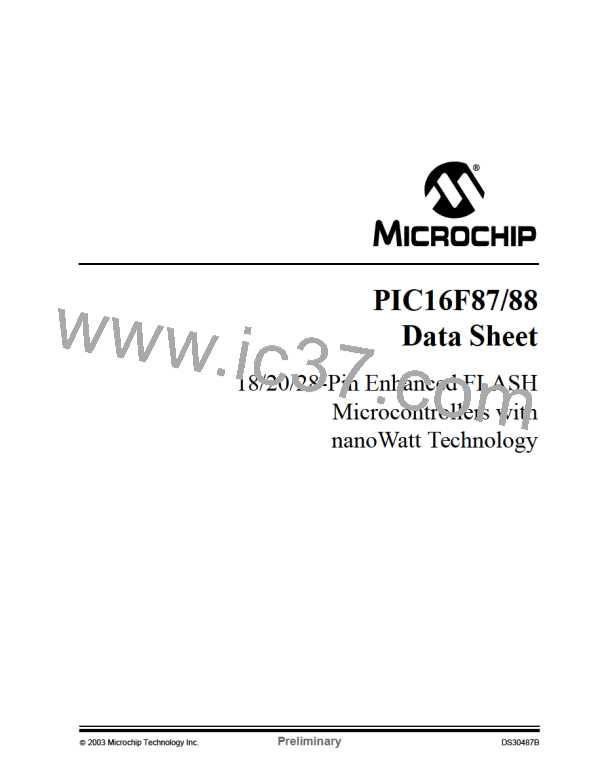PIC16F87/88
there is no oscillator start-up time required because
the primary clock is already stable; however, there is a
delay between the wake-up event and the following
Q2. An internal delay timer of 5-10 µs will suspend
operation after the RESET to allow the CPU to
become ready for code execution. The CPU and
peripheral clock will be held in the first Q1.
4.7.3.2
Returning to Primary Oscillator with
a RESET
A RESET will clear SCS<1:0> back to ‘00’. The
sequence for starting the primary oscillator following a
RESET is the same for all forms of RESET, including
POR. There is no transition sequence from the
alternate system clock to the primary system clock on
a RESET condition. Instead, the device will reset the
state of the OSCCON register and default to the
primary system clock. The sequence of events that
take place after this will depend upon the value of the
FOSC bits in the Configuration register. If the external
oscillator is configured as a crystal (HS, XT, or LP), the
CPU will be held in the Q1 state until 1024 clock cycles
have transpired on the primary clock. This is
necessary because the crystal oscillator had been
powered down until the time of the transition.
The sequence of events is as follows:
1. A device RESET is asserted from one of many
sources (WDT, BOR, MCLR, etc.).
2. The device resets and the CPU start-up timer is
enabled if in SLEEP mode. The device is held in
RESET until the CPU start-up time-out is
complete.
3. If the primary system clock is configured as an
external oscillator (HS, XT, LP), then the OST
will be active waiting for 1024 clocks of the pri-
mary system clock. While waiting for the OST,
the device will be held in RESET. The OST and
CPU start-up timers run in parallel.
During the oscillator start-up time, instruction
execution and/or peripheral operation is suspended.
Note:
If Two-Speed Clock Start-up mode is
enabled, the INTRC will act as the system
clock until the OST timer has timed out.
4. After both the CPU start-up and OST timers
have timed out, the device will wait for one addi-
tional clock cycle and instruction execution will
begin.
If the primary system clock is either RC, EC, or
INTRC, the CPU will begin operating on the first Q1
cycle following the wake-up event. This means that
FIGURE 4-10:
PRIMARY SYSTEM CLOCK AFTER RESET (HS, XT, LP)
(1)
TT1P
Q3 Q4 Q1 Q2 Q3 Q4 Q1 Q2 Q3 Q4
Q4
Q1
Q1 Q2 Q3 Q4 Q1 Q2
T1OSI
OSC1
TOST
TCPU
OSC2
(3)
(2)
TOSC
CPU Start-up
System Clock
Peripheral
Clock
RESET
SLEEP
OSTS
Program
Counter
0001h
0003h
PC
0000h
0004h
0005h
Note 1: TT1P = 30.52 µs.
2: TOSC = 50 ns minimum.
3: TCPU = 5-10 µs (1 MHz system clock).
2003 Microchip Technology Inc.
Preliminary
DS30487B-page 47

 MICROCHIP [ MICROCHIP ]
MICROCHIP [ MICROCHIP ]